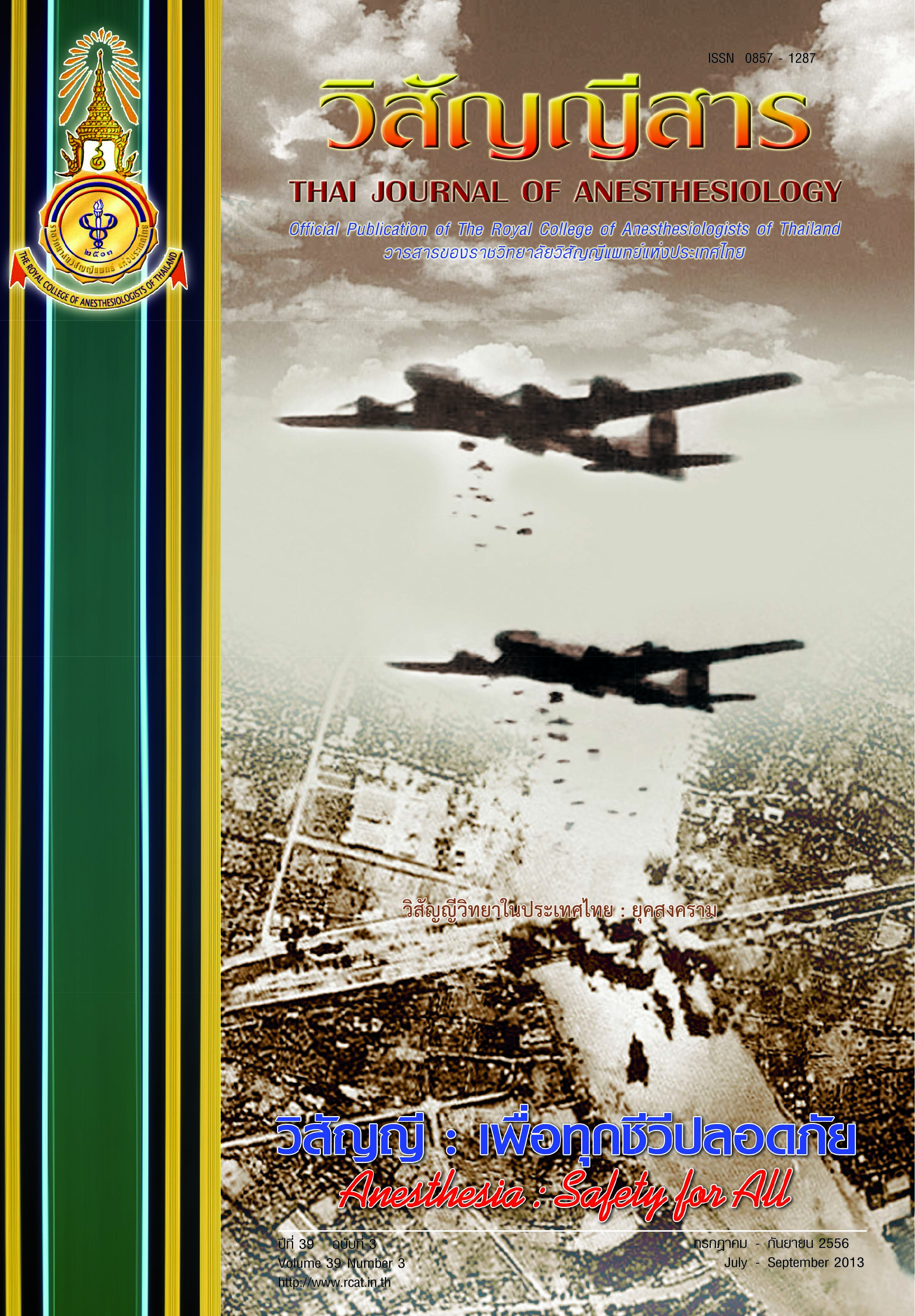Comparison of 0.1 mg and 0.2 mg intrathecal morphine after cesarean section in a Terms of pruritus, in Sanpasitthiprasong Hospital, Ubonratchathani, Thailand
Main Article Content
Abstract
Background: and objective: Spinal anesthesia (SA) with intrathecal morphine (ITMO) for cesarean section is very popular, especially in Sanpasitthiprasong Hospital, Ubonratchathani, Thailand. ITMO was claimed to relieve the postoperative pain and lasted longer than other methods However, pruritus was found in 70 - 85 percents. of phenol This kind of undesirable side effect is difficult to treat and does not respond well to antihistamine. Decreasing the dose of ITMO may provide substantial reduction in pruritus. The aim of this study was to compare the use of 0.1 mg and 0.2 mg of ITMO in terms of the incidence of pruritus.
Methods: A prospective, doubleblinded, randomized controlled trial was done in 80 participating women, scheduled for cesarean section under SA with 0.5% Hyperbaric Bupivacaine. They were allocated equally into two groups. Group I received ITMO 0.1 mg, Group II received ITMO 0.2 mg. All patients were followed up for 24 hours by a nurse anesthetist who was blinded. The incidence of pruritus, pain score, sedation score, nausea vomiting and the use of additional antipruritics, analgesics and antiemetics were recorded.
Results: The incidence of pruritus in Group I was lower than in Group II at 12 - 24 hour after SA (p<.05). There were no differences in the pain scores or the number of women requesting additional analgesics between the two groups. There were no differences in nausea vomiting or the number of women requesting antiemetics. There were no differences in sedation scores or patients’ satisfaction.
Conclusion: ITMO 0.1 mg produced less pruritus at 12 - 24 hour following cesarean section when compared with ITMO 0.2 mg while providing comparable postoperative analgesia.
การศึกษาเปรียบเทียบอาการคันระหว่างการใช้มอร์ฟีน 0.1 มิลลิกรัมและ 0.2 มิลลิกรัม เข้าช่องนํ้าไขสันหลัง สำหรับการผ่าตัดคลอด ในโรงพยาบาลสรรพสิทธิ ประสงค์ จังหวัดอุบลราชธานี
บทนำและวัตถุประสงค์: การระงับความรู้สึกในผู้ป่วยที่มารับการผ่าตัดคลอดบุตร โดยการใช้ยาชา และมอร์ฟีนเข้าในช่องนํ้าไขสันหลัง เป็นนิยมใช้กันอย่างแพร่หลาย โดยเฉพาะอย่างยิ่งโรงพยาบาลสรรพ สิทธิประสงค์ จังหวัดอุบลราชธานี ด้วยวิธีการดังกล่าวนั้นส่งผลต่อการระงับปวดหลังผ่าตัดที่ดีและระงับ ปวดได้นาน อย่างไรก็ตามผลข้างเคียงที่ไม่พึงประสงค์บางประการอาจเกิดขึ้นได้ เช่น อาการคัน ซึ่งอาจพบ ได้อยู่ระหว่างร้อยละ 70 ถึงร้อยละ 85 ซึ่งอาการคันดังกล่าวนี้จะรักษาได้ยากและมักไม่ตอบสนองต่อการให้ Antihistamine การลดขนาดของมอร์ฟีนในช่องนํ้าไขสันหลังอาจจะลดอาการคัน สำหรับงานวิจัยนี้ได้ดำเนิน การศึกษาเปรียบเทียบขนาดของมอร์ฟีน 0.1 มิลลิกรัม กับ 0.2 มิลลิกรัมเข้าช่องนํ้าไขสันหลังเพื่อลดอุบัติการณ์อาการคัน
วิธีการ: เป็นการศึกษาแบบ double- blind, randomized controlled trial ในผู้ป่วย 80 รายที่มารับ การผ่าตัดคลอดบุตรแบบไม่ฉุกเฉิน โดยแบ่งเป็น 2 กลุ่ม ได้แก่ กลุ่มศึกษา ได้รับมอร์ฟีนขนาด 0.1 มิลลิกรัมร่วมกับ ยาชา 0.5% Hyperbaric Bupivacaine เข้าช่องนํ้าไขสันหลัง และกลุ่มควบคุมได้รับมอร์ฟีนขนาด 0.2 มิลลิกรัม ร่วมกับยาชา 0.5% Hyperbaric Bupivacaine เข้าช่องนํ้าไขสันหลัง วัดผลจากอุบัติการณ์คันใน 24 ชั่วโมงหลัง ผ่าตัด
ผลการศึกษา: อุบัติการณ์คัน ในกลุ่มที่ได้รับมอร์ฟีนขนาด 0.1 มิลลิกรัมเข้าช่องนํ้าไขสันมีอาการคัน น้อยกว่ากลุ่มที่ได้รับมอร์ฟีน0.2 มิลลิกรัม ในช่วงเวลา 12 - 24 ชั่วโมงหลังผ่าตัด อย่างมีนัยสำ คัญทางสถิติ (p<0.05) ไม่พบความแตกต่างในระดับความปวดใน 24 ชั่วโมงหลังผ่าตัดและระดับการรู้สึกตัวรวมถึงอุบัติ การณ์คลื่นไส้อาเจียน และปริมาณของยาระงับปวด ยาแก้คลื่นไส้อาเจียน และระดับความพึงพอใจของผู้ป่วย
สรุป: มอร์ฟีนในนํ้าไขสันหลังขนาด 0.1 มิลลิกรัมมีอาการคันน้อยกว่า ขนาด 0.2 มิลลิกรัม ในช่วง 12 - 24 ชั่วโมงหลังผ่าตัด และระงับปวดหลังผ่าตัดคลอดบุตรไม่แตกต่างกัน


